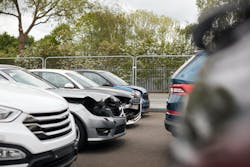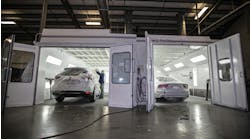In the first two parts of this article series, we discovered some of the ways overproduction can potentially harm your business. We explored specific elements of the collision repair process, and how they often compare to a relay race, though with far greater variables and complexities. We also touched on the human cost of overproduction in your shop and took an in-depth look at the financial cost of overproduction in your collision repair shop. And finally, we touched on “just in time” inventory and delayed return on investment (ROI). Buckle up for the third and final article in this series where we’ll learn how to mitigate and avoid overproduction altogether.
It’s not easy being lean
When you look at Lean manufacturing, it’s incredibly orderly. There is no backed up inventory. The production line moves in a succinct sequence, passing an item through all the necessary stages in an orderly manner as it goes along its way. Some refer to this as “single piece flow,” and it is the ideal state for manufacturing or production environments. It is largely achievable in these environments because there are very few variables.
What we’re talking about here is pacing; and it’s one of the best ways to mitigate overproduction.
Take a beverage company’s bottling operation for example. Those machines are always in balance moving down the production line. The production pacing is impeccable. There is not one area turning out way too many bottles, so it is backing up downstream operations causing bottles to back up and fall off the rails. Literally.
In a collision center, pacing is more challenging, and production “imbalance” is happening all the time. Most of us are oblivious to it. In a beverage bottling production environment, there are few variables. In a collision center, the number of variables can be in the thousands! For example, you don’t know what type of car is going to be dropped off or what type of repair it’s going to need. You can’t control when the accident happens or the size of the job. You can’t control much of anything. The number of variables is enormous. Something like single piece flow is nearly impossible in the collision repair environment, so what is the answer here? Buffers. And not the sort you’re used to using in a body shop.
Bring on the buffers
In Lean manufacturing, a “buffer” is strategically placed inventory designed to protect downstream operations from variables. In English? It means that between you and next person on the “production line” as it were, there is a little bit of excess inventory that helps control variations in flow. If the person “down line” from me gets their job completed very quickly, they would quickly out-run my ability to send them work. So that little bit of strategically placed inventory between us allows protection (a buffer) for the variables of job types that come to you. So, from an inventory standpoint, a little bit of excess inventory can be a good thing. Granted, the excess inventory is a form of waste; but the cost of that waste, when strategically and purposefully placed, brings value. That value is the protection against variations in job size and complexity. We are gaining something of value against that strategically placed waste.
Avoiding overproduction altogether
So, what can we do to reduce and even avoid overproduction? Well, first and foremost, we can do our best to avoid putting too much work into the business at any given point. Most of the time, excess inventory is a product of our choices as collision center operators. Knowing the “sweet spot” of inventory for your business is key to avoiding overproduction. That in and of itself is a whole separate topic. [We can do another article on this topic in the future.] For now, let’s look at a good analogy that helps describe inventory sweet spot. Think of it as your ideal body weight. If you weigh more than you like in the morning, move more and eat less. If you weigh less than you desire (is this really a thing?), eat more and move less. In a body shop, if you have more work than your sweet spot, consider slowing down the schedule a bit and getting more cars completed. If you have less than your sweet spot, pull the schedule forward if possible and capture keys to add more inventory.
Consider resource re-deployment
Secondly, limit the quantity of vehicles that are “waiting” for the next department. For example, decide to limit the excess inventory of painted cars waiting for reassembly to, say, two. If the paint department produces a third car that’s now waiting, move paint employees to help in reassembly to make room for that third vehicle. One or two people from paint helping in reassembly for 30 minutes can make up a lot of ground. After a space opens, move them back to paint. Resource re-deployment is easy when you have a limit on inventory. That way it’s very clear when to move to help and when to move back.
A great way AkzoNobel customers visualize this is by using Carbeat®. We developed our patented Carbeat software to help customers resolve the pacing challenge in collision repair shops. With Carbeat, every single person in the shop can see bottlenecks building by the quantity of cars in any given stage of the repair process. Carbeat transparently shows you the growing volume in any vertical column, making it very easy to identify the need for buffers or resource re-deployment.
That’s a wrap
Avoid bottlenecks. Strive for single piece flow. Use strategic inventory buffers. Re-deploy human resources to manage pacing. Sounds easy, right? It’s not. But most worthwhile things aren’t necessarily easy. The hardest part is realizing that overproduction is an issue for your business. Once you establish that, you now know the necessary steps to resolving the issue. Make a plan involving these steps to resolution and you’re more than halfway there.




